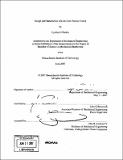Design and manufacture of low cost vaccine cooler
Author(s)
Panas, Cynthia Dawn Walker.
DownloadFull printable version (2.922Mb)
Other Contributors
Massachusetts Institute of Technology. Dept. of Mechanical Engineering.
Advisor
John G. Brisson, II.
Terms of use
Metadata
Show full item recordAbstract
Vaccines are very sensitive to temperature, needing to be held between 2 and 80°C to maintain potency. In developing countries where electricity and fuel supplies are unreliable, many vaccines are ruined due to thermal exposure. These are also the locations where vaccines are needed the most, yet often many of the vaccines given are ineffective. Long holdover vaccine coolers are designed to maintain a proper internal temperature during long periods of power loss. The most prevalent technology is the ice-lined cooler, but in the field these often have problem with freezing the vaccines. A vaccine cooler was designed that modifies the ice-jacket idea by separating the ice compartment and the vaccine chamber, connecting them through a heat transfer regulating device. The objective of this research is to design and prototype the heat transfer regulating device. After several design iterations a cooling loop filled with R-134a made of 1/8 piping, a 0.055 in ID capillary, and a Clippard normally-closed valve was combined with a modified car thermostat, using peanut oil as its working fluid, to create a thermosyphon type heat transfer device with a safety shutoff to prevent freezing. The prototype was manufactured and tested. It was found that with the proper amount of working fluid, it is possible to run the cooling loop at 4°C and pull heat from the vaccine chamber side to the ice. The peanut oil thermostat was tested and was found to open at a slightly lower temperature than expected, 2.5°C, but still within range. These results indicate that the concept is viable and should be tested in the vaccine cooler.
Description
Thesis (S.B.)--Massachusetts Institute of Technology, Dept. of Mechanical Engineering, 2007. Includes bibliographical references (p. 58).
Date issued
2007Department
Massachusetts Institute of Technology. Department of Mechanical EngineeringPublisher
Massachusetts Institute of Technology
Keywords
Mechanical Engineering.